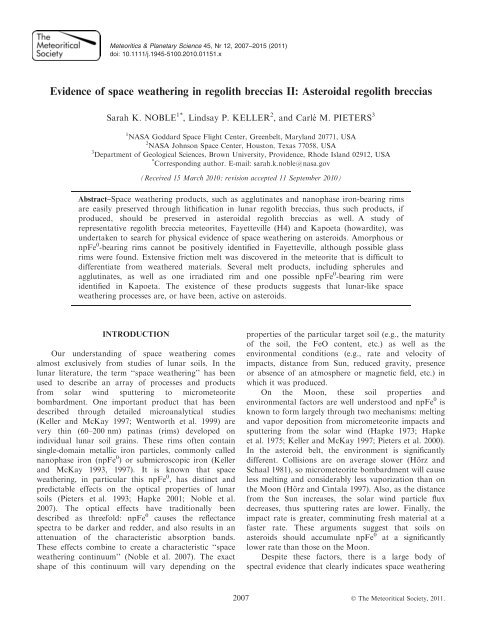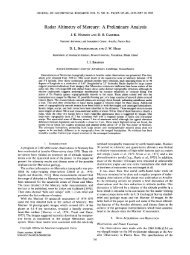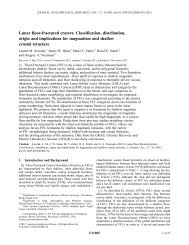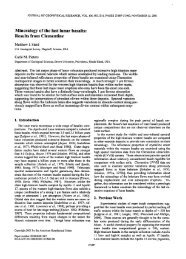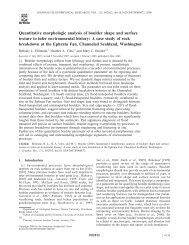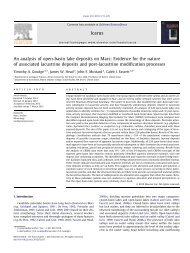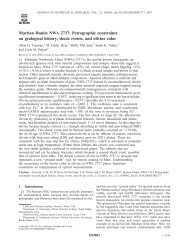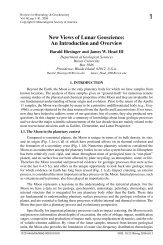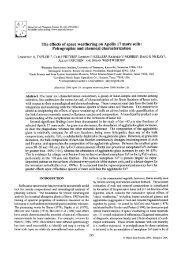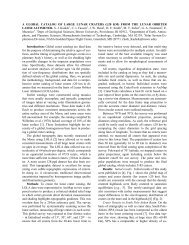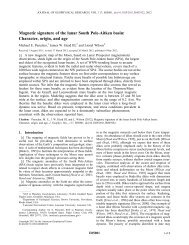4371 - Noble, S. K., L. P. Keller, and C. M. Pieters - Brown University ...
4371 - Noble, S. K., L. P. Keller, and C. M. Pieters - Brown University ...
4371 - Noble, S. K., L. P. Keller, and C. M. Pieters - Brown University ...
Create successful ePaper yourself
Turn your PDF publications into a flip-book with our unique Google optimized e-Paper software.
Meteoritics & Planetary Science 45, Nr 12, 2007–2015 (2011)<br />
doi: 10.1111/j.1945-5100.2010.01151.x<br />
Evidence of space weathering in regolith breccias II: Asteroidal regolith breccias<br />
Sarah K. NOBLE 1* , Lindsay P. KELLER 2 , <strong>and</strong> Carle´ M. PIETERS 3<br />
1 NASA Goddard Space Flight Center, Greenbelt, Maryl<strong>and</strong> 20771, USA<br />
2 NASA Johnson Space Center, Houston, Texas 77058, USA<br />
3 Department of Geological Sciences, <strong>Brown</strong> <strong>University</strong>, Providence, Rhode Isl<strong>and</strong> 02912, USA<br />
* Corresponding author. E-mail: sarah.k.noble@nasa.gov<br />
(Received 15 March 2010; revision accepted 11 September 2010)<br />
Abstract–Space weathering products, such as agglutinates <strong>and</strong> nanophase iron-bearing rims<br />
are easily preserved through lithification in lunar regolith breccias, thus such products, if<br />
produced, should be preserved in asteroidal regolith breccias as well. A study of<br />
representative regolith breccia meteorites, Fayetteville (H4) <strong>and</strong> Kapoeta (howardite), was<br />
undertaken to search for physical evidence of space weathering on asteroids. Amorphous or<br />
npFe 0 -bearing rims cannot be positively identified in Fayetteville, although possible glass<br />
rims were found. Extensive friction melt was discovered in the meteorite that is difficult to<br />
differentiate from weathered materials. Several melt products, including spherules <strong>and</strong><br />
agglutinates, as well as one irradiated rim <strong>and</strong> one possible npFe 0 -bearing rim were<br />
identified in Kapoeta. The existence of these products suggests that lunar-like space<br />
weathering processes are, or have been, active on asteroids.<br />
INTRODUCTION<br />
Our underst<strong>and</strong>ing of space weathering comes<br />
almost exclusively from studies of lunar soils. In the<br />
lunar literature, the term ‘‘space weathering’’ has been<br />
used to describe an array of processes <strong>and</strong> products<br />
from solar wind sputtering to micrometeorite<br />
bombardment. One important product that has been<br />
described through detailed microanalytical studies<br />
(<strong>Keller</strong> <strong>and</strong> McKay 1997; Wentworth et al. 1999) are<br />
very thin (60–200 nm) patinas (rims) developed on<br />
individual lunar soil grains. These rims often contain<br />
single-domain metallic iron particles, commonly called<br />
nanophase iron (npFe 0 ) or submicroscopic iron (<strong>Keller</strong><br />
<strong>and</strong> McKay 1993, 1997). It is known that space<br />
weathering, in particular this npFe 0 , has distinct <strong>and</strong><br />
predictable effects on the optical properties of lunar<br />
soils (<strong>Pieters</strong> et al. 1993; Hapke 2001; <strong>Noble</strong> et al.<br />
2007). The optical effects have traditionally been<br />
described as threefold: npFe 0 causes the reflectance<br />
spectra to be darker <strong>and</strong> redder, <strong>and</strong> also results in an<br />
attenuation of the characteristic absorption b<strong>and</strong>s.<br />
These effects combine to create a characteristic ‘‘space<br />
weathering continuum’’ (<strong>Noble</strong> et al. 2007). The exact<br />
shape of this continuum will vary depending on the<br />
properties of the particular target soil (e.g., the maturity<br />
of the soil, the FeO content, etc.) as well as the<br />
environmental conditions (e.g., rate <strong>and</strong> velocity of<br />
impacts, distance from Sun, reduced gravity, presence<br />
or absence of an atmosphere or magnetic field, etc.) in<br />
which it was produced.<br />
On the Moon, these soil properties <strong>and</strong><br />
environmental factors are well understood <strong>and</strong> npFe 0 is<br />
known to form largely through two mechanisms: melting<br />
<strong>and</strong> vapor deposition from micrometeorite impacts <strong>and</strong><br />
sputtering from the solar wind (Hapke 1973; Hapke<br />
et al. 1975; <strong>Keller</strong> <strong>and</strong> McKay 1997; <strong>Pieters</strong> et al. 2000).<br />
In the asteroid belt, the environment is significantly<br />
different. Collisions are on average slower (Ho¨rz <strong>and</strong><br />
Schaal 1981), so micrometeorite bombardment will cause<br />
less melting <strong>and</strong> considerably less vaporization than on<br />
the Moon (Ho¨rz <strong>and</strong> Cintala 1997). Also, as the distance<br />
from the Sun increases, the solar wind particle flux<br />
decreases, thus sputtering rates are lower. Finally, the<br />
impact rate is greater, comminuting fresh material at a<br />
faster rate. These arguments suggest that soils on<br />
asteroids should accumulate npFe 0 at a significantly<br />
lower rate than those on the Moon.<br />
Despite these factors, there is a large body of<br />
spectral evidence that clearly indicates space weathering<br />
2007<br />
Ó The Meteoritical Society, 2011.
2008 S. K. <strong>Noble</strong> et al.<br />
influences some asteroids enough to affect their optical<br />
properties. In general, the spectra of asteroids do not<br />
match the spectra of our collection of meteorites.<br />
Particularly, the spectra of S-type asteroids, the most<br />
abundant type, do not correspond well to the spectra of<br />
the most abundant type of meteorites, ordinary<br />
chondrites (OCs). The asteroid spectra tend to be redder<br />
than the meteorites with a steep curvature in the visible<br />
wavelengths. Binzel et al. (1996) have identified near-<br />
Earth asteroids with spectral properties covering the<br />
range from S-type to spectra similar to those of OC<br />
meteorites, suggesting an ongoing process is occurring<br />
that can alter the spectra of OC material to look like<br />
S-type asteroids. There is also evidence of regolith<br />
alteration from Galileo’s flybys of Gaspra <strong>and</strong> Ida<br />
showing spectral differences at fresh craters. With time,<br />
the spectra of Ida <strong>and</strong> Gaspra appear to redden <strong>and</strong><br />
lose spectral contrast (Chapman 1996). Evidence from<br />
NEAR-Shoemaker’s X-ray measurements of Eros<br />
indicates an OC composition despite an S-type<br />
spectrum, again suggesting that space weathering<br />
processes have altered the optical properties of the<br />
surface (Trombka et al. 2000; Clark et al. 2001).<br />
Similarly, the S-type asteroid Itokawa was shown to be<br />
of OC composition using data from the Hayabusa<br />
spacecraft (Okada et al., 2006; Hiroi et al. 2006).<br />
Our recent work detailing the effects of npFe 0 on<br />
the optical properties of lunar soil grains has<br />
demonstrated that the spectral properties of S-type<br />
asteroids directly mimic the effects predicted for small<br />
amounts of npFe 0 on grains of OC regolith (<strong>Pieters</strong><br />
et al. 2000; <strong>Noble</strong> et al. 2007). This is in agreement with<br />
the modeling of Hapke (2001), who arrives at the same<br />
conclusion. We have shown that the precise expression<br />
of space weathering-induced changes will vary as a<br />
function of npFe 0 content. Adding significant amounts<br />
(>0.3 wt%) of npFe 0 to a soil results in an overall<br />
reddening <strong>and</strong> darkening throughout the Vis ⁄ NIR<br />
region. By contrast, adding only very small amounts<br />
(
Space weathering of asteroidal regolith breccias 2009<br />
a.<br />
rim<br />
grain<br />
appears that vesicular rims are a result of the evolution<br />
of implanted gasses from within the host grain. A more<br />
complete description of glass <strong>and</strong> vesicular rims can be<br />
found in <strong>Noble</strong> et al. (2005).<br />
METHODS<br />
100nm<br />
b.<br />
500nm<br />
c.<br />
npFe 0<br />
NpFe 0 -bearing rim<br />
Amorphous rim<br />
Two different regolith breccia meteorites were<br />
selected for this study, Fayetteville (H4 OC) <strong>and</strong><br />
Kapoeta (howardite). Two thin sections of Fayetteville<br />
were acquired from the Smithsonian Institution.<br />
Samples of Kapoeta were acquired from both the<br />
American Museum of Natural History <strong>and</strong> the Field<br />
Museum. Demountable (superglue) polished thin<br />
sections of Kapoeta were prepared at the NASA<br />
Johnson Space Center. Scanning electron microscope<br />
(SEM) analysis was performed on all thin sections on a<br />
JEOL 5910LV SEM equipped with an IXRF thinwindow<br />
energy-dispersive X-ray (EDX) detector.<br />
Electron microprobe analysis was performed using a<br />
Cameca SX100 microprobe with five wavelength<br />
dispersive detectors. Following the SEM analysis, we<br />
identified several regions of interest from each of the<br />
thin sections. Copper TEM grids were glued to the<br />
regions of interest <strong>and</strong> removed from the thin sections<br />
by soaking in acetone. The samples were ion milled to<br />
electron transparency using a Gatan Duo-Mill <strong>and</strong><br />
carbon coated for analysis in the transmission electron<br />
microscope (TEM). The TEM analyses were performed<br />
on a JEOL 2000FX 200 kV STEM equipped with a<br />
Link thin-window EDX detector.<br />
d.<br />
500nm<br />
500nm<br />
Fig. 2. TEM bright-field images of lunar breccia rims: a)<br />
npFe 0 -bearing rim from breccia 10068. b) Amorphous rim<br />
from breccia 15505. c) Glass rim (indicated by arrows) from<br />
breccia 79035. d) Vesicular rims (indicated by arrows) also<br />
from breccia 79035 (after <strong>Noble</strong> et al. 2005).<br />
rims were identified in every lunar breccia examined.<br />
They are rich in npFe 0 <strong>and</strong> share the same wide range of<br />
compositions as agglutinitic glass. Vesicular rims, in<br />
contrast, are generally compositionally indistinguishable<br />
from their host grain. Rather than being acquired, it<br />
Fayetteville<br />
The Fayetteville OC is a Class A regolith breccia<br />
which has experienced only low shock pressures<br />
(1–5 GPa) <strong>and</strong> little to none of its matrix material has<br />
melted (Bischoff et al. 1983). It has well-developed<br />
light ⁄ dark structure with high levels of trapped noble<br />
gasses (Black 1972), which implies surface exposure.<br />
Fayetteville is also one of only two meteorites that have<br />
previously been found to contain ‘‘true analogs of<br />
agglutinates’’ (Basu <strong>and</strong> McKay 1983), further attesting<br />
to its ‘‘weathered’’ status.<br />
Like most regolith breccias, Fayetteville is<br />
composed of light <strong>and</strong> dark regions. The dark regions,<br />
where the noble gasses are concentrated, contain<br />
numerous micrometer-scale Fe-metal <strong>and</strong> FeS particles,<br />
consistent with earlier findings (Britt <strong>and</strong> <strong>Pieters</strong> 1994).<br />
TEM analysis reveals that within these dark areas are<br />
many small regions of melt glass that contain abundant<br />
nano-scale Fe-metal <strong>and</strong> FeS particles. In Fig. 3 are<br />
shown several examples of these nano-scale features.<br />
The glassy material is largely located along cracks <strong>and</strong>
2010 S. K. <strong>Noble</strong> et al.<br />
a.<br />
c.<br />
grain<br />
inclusionrich<br />
glass<br />
grain<br />
100nm<br />
b.<br />
grain<br />
grain<br />
200nm<br />
d.<br />
inclusionrich<br />
glass<br />
inclusionrich<br />
glass<br />
inclusionrich<br />
glass<br />
grain<br />
grain<br />
100nm<br />
200nm<br />
Fig. 3. TEM bright-field images of inclusion-rich glasses in Fayetteville. The glass in images (a) <strong>and</strong> (b) are clearly filling in<br />
cracks between grains. Images (c) <strong>and</strong> (d) represent more ambiguous cases where the glass may be surrounding individual grains.<br />
between grain boundaries (Figs. 3a <strong>and</strong> 3b) <strong>and</strong><br />
therefore is likely to be formed in the breccia as a result<br />
of friction melting (van der Bogert et al. 2001), rather<br />
than by sputtering <strong>and</strong> ⁄ or micrometeorite impactinduced<br />
vaporization ⁄ melting in the regolith. Some glass<br />
regions, however, are more ambiguous. Figures 3c <strong>and</strong><br />
3d are two examples of cases where inclusion-rich glass<br />
appears to be surrounding grains. These ‘‘rims’’ are<br />
rather thick (200 nm in places), <strong>and</strong> their large<br />
inclusions <strong>and</strong> discontinuous nature are inconsistent<br />
with an origin as vapor- ⁄ sputter-deposited rims. They<br />
could, however, be analogous to the glass rims observed<br />
on lunar breccia grains (<strong>Noble</strong> et al. 2005).<br />
Despite the low shock experienced by this<br />
meteorite, the effects of friction melting are pervasive.<br />
There is so much inclusion-rich glass throughout the<br />
sample that the positive identification of true space<br />
weathering products is made nearly impossible.<br />
Kapoeta<br />
Because of their high metal content, OC regolith<br />
breccias are vulnerable to micro- <strong>and</strong> nano-scale<br />
dispersion of metal by shock <strong>and</strong> ⁄ or friction. This<br />
dispersion of fine-grained metal makes identifying<br />
weathering products problematic, if not impossible. To<br />
avoid this problem, a howardite was selected.<br />
Howardites, part of the howardite, eucrite, <strong>and</strong><br />
diogenite (HED) meteorite group, come from the<br />
surface of a differentiated body, probably 4 Vesta<br />
(McCord et al. 1970). Because howardites are basaltic in<br />
nature, they do not have the high metal content of OC<br />
<strong>and</strong> they are more directly comparable to the lunar<br />
mare regolith breccias previously investigated.<br />
Like Fayetteville, Kapoeta is also a Class A regolith<br />
breccia, indicating low shock. It has, in fact, been<br />
classified as ‘‘friable’’ (Warren 2001) <strong>and</strong> therefore<br />
would be expected to have retained any weathering<br />
products acquired before <strong>and</strong> ⁄ or during lithification<br />
(<strong>Noble</strong> et al. 2005). Despite being highly variable,<br />
Kapoeta has high noble gas content (e.g., Black 1972).<br />
In addition, microcraters have been identified in the<br />
meteorite (<strong>Brown</strong>lee <strong>and</strong> Rajan 1973), which provides<br />
direct evidence of surface exposure. Sedimentary<br />
structures such as laminae <strong>and</strong> accretionary lapilli have<br />
also been described (Pedroni 1991). While clearly some<br />
of the constituent grains of Kapoeta have been directly<br />
exposed at the surface, the majority likely have not. It<br />
has been estimated based on cosmic ray exposure that<br />
not more than about 20% of grains in most meteorite
Space weathering of asteroidal regolith breccias 2011<br />
regolith breccias have been directly exposed at the<br />
surface (Macdougall 1981). This is in significant<br />
contrast to lunar regolith breccias in which nearly all<br />
grains have experienced surface exposure.<br />
Vesta, the probable parent body of Kapoeta, is<br />
unusual among the asteroid population in that its<br />
Vis ⁄ NIR spectrum actually does match reasonably well<br />
with meteorites in our collection, the HEDs (i.e., it does<br />
not appear to be significantly space weathered). There<br />
are two possible explanations for this: Vesta either<br />
weathers very slowly, or it has been recently resurfaced.<br />
As was previously mentioned, the surface of Vesta is<br />
largely basaltic, similar to the lunar mare. We know<br />
that lunar basalts weather, thus there is no reason to<br />
think that Vesta would be immune to weathering. What<br />
we do not know is the rate at which such a surface in<br />
the asteroid environment will weather. Experimental<br />
data suggest that pyroxene weathers more slowly than<br />
olivine under the same conditions (Yamada et al. 1999;<br />
Hiroi <strong>and</strong> Sasaki 2001; Sasaki et al. 2003), thus Vesta’s<br />
basaltic surface may weather at a slower rate than the<br />
surface of a more olivine-rich chondritic body. There is<br />
also evidence from UV spectral data that suggest that<br />
Vesta’s western hemisphere is space weathered, but to<br />
such a small degree that the weathering effects can only<br />
be seen in the UV spectrum <strong>and</strong> are not apparent in the<br />
Vis ⁄ NIR spectral range (Hendrix et al. 2003). It takes<br />
very little npFe 0 to begin to affect the Vis ⁄ NIR spectral<br />
properties of a soil (<strong>Noble</strong> et al. 2007); noticeable<br />
changes in the Vis ⁄ NIR spectral continuum should<br />
occur even if only 1% or 2% of grains have npFe 0 -<br />
bearing rims. Thus, the current surface must be below<br />
this threshold. It is possible that Vesta was more<br />
weathered at one time. A large impact crater on Vesta<br />
suggests the possibility that Vesta may have been<br />
thoroughly resurfaced in the recent past, effectively<br />
resetting the weathering clock (<strong>Pieters</strong> <strong>and</strong> Binzel 1994).<br />
The lithification age of Kapoeta is difficult to<br />
determine. From radiometric dating of individual clasts,<br />
we know that the breccia must have formed more recently<br />
than its youngest known clast, approximately 3.5 Ga<br />
(Bogard 1982), <strong>and</strong> it must be older than its exposure age<br />
of approximately 3 Ma (Caffee <strong>and</strong> Nishiizumi 2001). By<br />
calculating the shielding from the systematics of the<br />
distribution of several noble gas isotopes, Caffee <strong>and</strong><br />
Nishiizumi (2001) inferred that the breccia was buried for<br />
approximately 10 Ma before being ejected from its parent<br />
body. Therefore, the age of the formation of the breccia<br />
can only be constrained to between approximately<br />
3.5 billion <strong>and</strong> 13 million years ago.<br />
If Kapoeta is at the older end of that range <strong>and</strong><br />
was assembled during a period when impact rates were<br />
higher (Hartmann et al. 2007), particularly rates of<br />
larger impactors (Chapman <strong>and</strong> Davis 1975), that<br />
environment would result in shorter gardening times<br />
<strong>and</strong> therefore less time for space weathering products to<br />
build up in the regolith. In this case, weathering<br />
products in Kapoeta should be extremely rare.<br />
If instead, we assume that Kapoeta is younger <strong>and</strong><br />
that conditions on Vesta were similar when the breccia<br />
was formed to current conditions <strong>and</strong> therefore<br />
approximately 1% of surface grains had npFe 0 -bearing<br />
rims, <strong>and</strong> that roughly 20% of the grains in Kapoeta<br />
were directly exposed at the surface, then we should<br />
expect to find one npFe 0 -bearing rim for every<br />
approximately 500 grains.<br />
Glass Rims<br />
KAPOETA SEM RESULTS<br />
The most common type of rims found in lunar<br />
regolith breccias are glass rims (<strong>Noble</strong> et al. 2005). An<br />
example of a lunar glass rim is shown in Fig. 2c. These<br />
rims are rich in npFe 0 , but are distinguished from<br />
npFe 0 -bearing soil rims by their thickness, obvious flow<br />
features, <strong>and</strong> other characteristics, which indicate that<br />
they were deposited as a melt <strong>and</strong> not via vapor or<br />
sputter deposition as the soil rims are. Glass rims are<br />
not commonly found in lunar soils but only in regolith<br />
breccias, <strong>and</strong> thus are assumed to be part of the<br />
breccia-forming process itself. As such, they are not,<br />
strictly speaking, space weathering products, but they<br />
still provide important clues about the conditions on the<br />
surface of an airless body.<br />
In Fig. 4 are several examples of glass rims which<br />
were identified in Kapoeta. Rims in the meteorite are<br />
less extensive than what was found in the lunar<br />
breccias. Not only are there fewer rims but, the rims<br />
that we find tend to be less continuous than they were<br />
for the lunar case. The abundance of rims in lunar<br />
breccias varies from breccia to breccia, in some soils<br />
10–20% of grains are at least partially rimmed; in<br />
others, only a h<strong>and</strong>ful of rims (
2012 S. K. <strong>Noble</strong> et al.<br />
Fig. 4. SEM backscatter images of examples of glass rims<br />
(indicated by arrows) in Kapoeta.<br />
shown in Fig. 6. The presence of spherules, agglutinates,<br />
<strong>and</strong> glass rims confirms that melting does occur during<br />
impact on asteroids, as has been discussed by others<br />
(e.g., Ho¨rz <strong>and</strong> Schaal 1981).<br />
KAPOETA TEM RESULTS<br />
Remarkably little glass was observed at this scale<br />
despite the glass products seen in SEM. Three TEM<br />
sections were thoroughly examined, representing<br />
approximately 1000 grains. Only one possible npFe 0 -<br />
bearing rim was identified. This rim is shown in Fig. 7.<br />
The amorphous rim material surrounds >50% of the<br />
grain <strong>and</strong> is about 25 nm thick, thinner than a typical<br />
lunar rim, but within the range observed on lunar<br />
Fig. 5. SEM backscatter images of Kapoeta agglutinates, note<br />
the abundant vesicules.<br />
grains. It contains abundant opaque nanoparticles in<br />
the approximately 2–5 nm range, consistent with npFe 0 .<br />
Finding only a single rim is consistent with our<br />
prediction of one rim per approximately 500 grains. In<br />
addition, one amorphous rim (with no npFe 0 ) was also<br />
identified (Fig. 8). Such amorphous rims are also<br />
common in lunar soils <strong>and</strong> are a result of solar windinduced<br />
radiation damage (<strong>Keller</strong> <strong>and</strong> McKay 1997).<br />
DISCUSSION<br />
A variety of space weathering products have been<br />
identified in the howardite Kapoeta that represent direct
Space weathering of asteroidal regolith breccias 2013<br />
a.<br />
nanophase<br />
particles<br />
pyroxene<br />
b.<br />
100nm<br />
rim<br />
nanophase<br />
particles<br />
epoxy<br />
pyroxene<br />
Fig. 6. SEM backscatter images of Kapoeta spherules<br />
(identified with white arrows).<br />
evidence of many of the same space weathering<br />
processes that we underst<strong>and</strong> from the lunar case. The<br />
amorphous rim is the result of solar wind irradiation<br />
<strong>and</strong> agglutinates <strong>and</strong> spherules are evidence of melt<br />
formation due to micrometeorite (<strong>and</strong> larger) impact.<br />
NpFe 0 -rich rims can be formed either through vapor<br />
deposition or sputtering, although sputtering is more<br />
likely here due to the lower impact velocities expected in<br />
the Main Belt. While the environmental conditions <strong>and</strong><br />
target compositions are significantly different on<br />
asteroids compared to the Moon, there is no need to<br />
invoke exotic processes to account for weathering on<br />
asteroids; rather we need to work to underst<strong>and</strong> how<br />
those compositional <strong>and</strong> environmental differences<br />
affect the manifestation of different components of<br />
space weathering.<br />
Vernazza et al. (2009) suggest that due to the rapid<br />
time scales for spectral changes associated with space<br />
weathering, solar wind must be the dominant factor in<br />
asteroid weathering over micrometeorite bombardment.<br />
If that is the case, one would expect to find amorphous<br />
<strong>and</strong> npFe 0 -rich rims in asteroidal regolith, but only<br />
rarely agglutinates, spherules, or other glass products.<br />
Although we found several such melt products <strong>and</strong> only<br />
one npFe 0 -rich rim <strong>and</strong> one amorphous rim in our<br />
study, our results are not necessarily contradictory.<br />
20nm<br />
Fig. 7. a) TEM bright-field image of possible npFe 0 -bearing<br />
rim in Kapoeta. b) Close-up of the region outlined in (a)<br />
showing npFe 0 inclusions.<br />
50 nm<br />
Fig. 8. TEM bright-field image of an irradiated rim (indicated<br />
by arrows) in Kapoeta.<br />
Because of their size, agglutinates <strong>and</strong> spherules are<br />
easily identified using SEM; rims, on the other h<strong>and</strong>,<br />
can only be seen on a TEM scale. Therefore our results<br />
are biased in favor of melt products because they are so<br />
much easier to find.
2014 S. K. <strong>Noble</strong> et al.<br />
CONCLUSIONS<br />
Rare end products of space weathering processes<br />
were identified in two meteorite regolith breccias. The<br />
H4 OC Fayetteville lacks the typical space-weathered<br />
materials observed in lunar samples such as<br />
agglutinates, melt spherules, <strong>and</strong> grain rims. Impactrelated<br />
friction melts at grain contacts were commonly<br />
observed <strong>and</strong> complicate the search for amorphous rims<br />
<strong>and</strong> agglutinitic glasses. Although they could not be<br />
confirmed as distinct from the friction melt, several<br />
possible glass rims were identified in the breccia.<br />
The howardite Kapoeta was found to contain<br />
impact-related glass products in the form of agglutinates,<br />
glass rims, <strong>and</strong> melt spherules. One probable vapor- or<br />
sputter-deposited rim <strong>and</strong> one amorphous rim were<br />
identified. The identification of a single npFe 0 -bearing<br />
rim <strong>and</strong> a single amorphous rim underscores three<br />
points: (1) such rims are created on asteroids; (2) they are<br />
extremely rare in regolith breccias; <strong>and</strong> (3) both solar<br />
wind irradiation <strong>and</strong> micrometeorite bombardment<br />
contribute to space weathering on asteroid regoliths.<br />
Acknowledgments—NASA support (NGT9-66, SKN),<br />
(NAG5-11763, CMP), <strong>and</strong> (RTOP 344-31-40-07, LPK)<br />
is gratefully acknowledged. We thank A. Basu <strong>and</strong><br />
S. Sasaki for thorough reviews that improved the<br />
quality of this manuscript. The authors express their<br />
thanks to the Smithsonian, American Museum of<br />
Natural History, <strong>and</strong> the Field Museum for providing<br />
meteorite samples.<br />
Editorial H<strong>and</strong>ling—Dr. Beth Ellen Clark<br />
REFERENCES<br />
Basu A. <strong>and</strong> McKay D. S. 1983. Rarity of lunar soil analogs<br />
in meteorites. Meteoritics 18:263–264.<br />
Binzel R. P., Bus S. J., Burbine T. H., <strong>and</strong> Sunshine J. M.<br />
1996. Spectral properties of near-Earth asteroids: Evidence<br />
for sources of ordinary chondrite meteorites. Science<br />
273:946–948.<br />
Bischoff A., Rubin A. E., Keil K., <strong>and</strong> Sto¨ffler D. 1983.<br />
Lithification of gas-rich chondrite regolith breccias by<br />
grain boundary <strong>and</strong> localized shock melting. Earth <strong>and</strong><br />
Planetary Science Letters 66:1–10.<br />
Black D. C. 1972. On the origin of trapped helium, neon, <strong>and</strong><br />
argon isotopic variations in meteorites I. Gas-rich<br />
meteorites, lunar soil <strong>and</strong> breccia. Geochimica et<br />
Cosmochimica Acta 36:347–375.<br />
Bogard D. 1982. Chronology of breccias. Workshop on lunar<br />
breccias <strong>and</strong> soils <strong>and</strong> their meteoritic components. LPI<br />
Technical Report 82-02:26-30. Houston, Texas: Lunar <strong>and</strong><br />
Planetary Institute.<br />
van der Bogert C. H., Schultz P. H., <strong>and</strong> Spray J. G. 2001.<br />
Impact-darkening via high strain-rate deformation during<br />
impact: Spectral <strong>and</strong> chemical analyses (abstract #2167).<br />
32nd Lunar <strong>and</strong> Planetary Science Conference.<br />
CD-ROM.<br />
Britt D. T. <strong>and</strong> <strong>Pieters</strong> C. M. 1994. Darkening in black <strong>and</strong><br />
gas-rich ordinary chondrites: The spectral effects of<br />
opaque morphology <strong>and</strong> distribution. Geochimica et<br />
Cosmochimica Acta 58:3905–3919.<br />
<strong>Brown</strong>lee D. E. <strong>and</strong> Rajan R. S. 1973. Micrometeorite craters<br />
discovered on chondrule-like objects from Kapoeta<br />
meteorite. Science 182:1341–1344.<br />
Caffee M. W. <strong>and</strong> Nishiizumi K. 2001. Exposure history of<br />
separated phases from the Kapoeta meteorite. Meteoritics<br />
& Planetary Science 36:429–437.<br />
Chapman C. R. 1996. S-type asteroids, ordinary chondrites,<br />
<strong>and</strong> space weathering: The evidence from Galileo’s fly-bys<br />
of Gaspra <strong>and</strong> Ida. Meteoritics & Planetary Science<br />
31:699–725.<br />
Chapman C. R. <strong>and</strong> Davis D. R. 1975. Asteroid collisional<br />
evolution: Evidence for a much larger early population.<br />
Science 190:553–555.<br />
Clark B. E., Lucey P., Helfenstein P., Bell J. F. III, Peterson<br />
C., Veverka J., McConnochie T., Robinson M. S., Bussey<br />
B., Murchie S. L., Izenberg N. I., <strong>and</strong> Chapman C. R.<br />
2001. Space weathering on Eros: Constraints from albedo<br />
<strong>and</strong> spectral measurements of Psyche crater. Meteoritics &<br />
Planetary Science 36:1617–1637.<br />
Hapke B. 1973. Darkening of silicate rocks by solar wind<br />
sputtering. Moon 7:342–355.<br />
Hapke B. 2001. Space weathering from Mercury to the asteroid<br />
belt. Journal of Geophysical Research 106:10039–10073.<br />
Hapke B., Cassidy W., <strong>and</strong> Wells E. 1975. Effects of vaporphase<br />
deposition processes on the optical, chemical <strong>and</strong><br />
magnetic properties of the lunar regolith. Moon 13:339–353.<br />
Hartmann W. K., Quantin C., <strong>and</strong> Mangold N. 2007. Possible<br />
long-term decline in impact rates: 2. Lunar impact-melt<br />
data regarding impact history. Icarus 186:11–23.<br />
Hendrix A. R., Vilas F., <strong>and</strong> Festou M. C. 2003. Vesta’s UV<br />
lightcurve: Hemispheric variation in brightness <strong>and</strong><br />
spectral reversal. Icarus 162:1–9.<br />
Hiroi T. <strong>and</strong> Sasaki S. 2001. Importance of space weathering<br />
simulation products in compositional modeling of<br />
asteroids: 349 Dembowska <strong>and</strong> 446 Aeternitas as<br />
examples. Meteoritics & Planetary Science 36:1587–1596.<br />
Hiroi T., Abe M., Kitazato K., Abe S., Clark B. E., Sasaki S.,<br />
Ishiguro M., <strong>and</strong> Barnouin-Jha O. S. 2006. Developing<br />
space weathering on the asteroid 25143 Itokowa. Nature<br />
443:56–58.<br />
Ho¨rz F. <strong>and</strong> Cintala M. 1997. Impact experiments related to<br />
the evolution of planetary regoliths. Meteoritics &<br />
Planetary Science 32:179–209.<br />
Ho¨rz F. <strong>and</strong> Schaal R. B. 1981. Asteroidal agglutinate<br />
formation <strong>and</strong> implications for asteroidal surfaces. Icarus<br />
46:337–353.<br />
<strong>Keller</strong> L. P. <strong>and</strong> McKay D. S. 1993. Discovery of vapor<br />
deposits in the lunar regolith. Science 261:1305–1307.<br />
<strong>Keller</strong> L. P. <strong>and</strong> McKay D. S. 1997. The nature <strong>and</strong> origin of<br />
rims on lunar soil grains. Geochimica et Cosmochimica<br />
Acta 61:2331–2341.<br />
MacDougall J. D. 1981. Space exposure of breccia components.<br />
Workshop on lunar breccias <strong>and</strong> soils <strong>and</strong> their meteoritic<br />
components. LPI Technical Report 82-02:94-96. Houston,<br />
Texas: Lunar <strong>and</strong> Planetary Institute.<br />
McCord T. B., Adams J. B., <strong>and</strong> Johnson T. V. 1970.<br />
Asteroid Vesta; spectral reflectivity <strong>and</strong> compositional<br />
implications. Science 168:1445–1447.
Space weathering of asteroidal regolith breccias 2015<br />
Morris D. V. 1978. The surface exposure (maturity) of lunar<br />
soils: Some concepts <strong>and</strong> I s ⁄ FeO compilation. Proceedings,<br />
9th Lunar <strong>and</strong> Planetary Science Conference. pp. 2287–<br />
2297.<br />
<strong>Noble</strong> S. K., <strong>Pieters</strong> C. M., Taylor L. A., Morris R. V., Allen<br />
C. C., McKay D. S., <strong>and</strong> <strong>Keller</strong> L. P. 2001. The optical<br />
properties of the finest fraction of lunar soil: Implications<br />
for space weathering. Meteoritics & Planetary Science<br />
36:31–42.<br />
<strong>Noble</strong> S. K., <strong>Pieters</strong> C. M., <strong>and</strong> <strong>Keller</strong> L. P. 2005. Evidence<br />
of space weathering in regolith breccias I: Lunar regolith<br />
breccias. Meteoritics & Planetary Science 40:397–408.<br />
<strong>Noble</strong> S. K., <strong>Pieters</strong> C. M., Hiroi T., <strong>and</strong> Taylor L. A. 2006.<br />
Using the modified Gaussian model to extract quantitative<br />
data from lunar soils. Journal of Geophysical Research<br />
111:E11009, doi:10.1029/2006JE002721.<br />
<strong>Noble</strong> S. K., <strong>Keller</strong> L. P., <strong>and</strong> <strong>Pieters</strong> C. M. 2007. An<br />
experimental approach to underst<strong>and</strong>ing the optical effects<br />
of space weathering. Icarus 192:629–642.<br />
Okada T., Shirai K., Yamamoto Y., Arai T., Ogawa K.,<br />
Hosono K., <strong>and</strong> Kato M. 2006. X-ray fluorescence<br />
spectrometry of asteroid Itokawa by Hayabusa. Science<br />
312:1138–1141.<br />
Pedroni A. 1991. Accretionary lapilli <strong>and</strong> other sedimentary<br />
textures of the howardite Kapoeta (abstract). 22nd Lunar<br />
<strong>and</strong> Planetary Science Conference. pp. 1045–1046.<br />
<strong>Pieters</strong> C. M. <strong>and</strong> Binzel R. P. 1994. Young Vesta (regolith)?<br />
(abstract). 24th Lunar <strong>and</strong> Planetary Science Conference.<br />
pp. 1083–1084.<br />
<strong>Pieters</strong> C. M., Fischer E. M., Rode O., <strong>and</strong> Basu A. 1993.<br />
Optical effects of space weathering: The role of the finest<br />
fraction. Journal of Geophysical Research 98:20,817–20,824.<br />
<strong>Pieters</strong> C. M., Taylor L. A., <strong>Noble</strong> S. K., <strong>Keller</strong> L. P., Hapke<br />
B. H., Morris R. V., Allen C. C., McKay D. S., <strong>and</strong><br />
Wentworth S. 2000. Space weathering on airless bodies:<br />
Resolving a mystery with lunar samples. Meteoritics &<br />
Planetary Science 35:1101–1107.<br />
Sasaki S., Kurahashi E., Yamanaka C., <strong>and</strong> Nakamura K.<br />
2003. Laboratory simulation of space weathering: Changes<br />
of optical properties <strong>and</strong> TEM ⁄ ESR confirmation of<br />
nanophase metallic iron. Advances in Space Research<br />
31:2537–2542.<br />
Trombka J. I. <strong>and</strong> the NEAR-Shoemaker X-ray Spectrometer<br />
Team. 2000. The elemental composition of asteroid<br />
433 Eros: Results of the NEAR-Shoemaker X-ray<br />
spectrometer. Science 289:2101–2105.<br />
Vernazza P., Binzel R. P., Rossi A., Fulchignoni M., <strong>and</strong><br />
Birlan M. 2009. Solar wind as the origin of rapid<br />
reddening of asteroid surfaces. Nature 458:993–<br />
995.<br />
Warren P. H. 2001. Porosities of lunar meteorites: Strength,<br />
porosity, <strong>and</strong> petrologic screening during the meteorite<br />
delivery process. Journal of Geophysical Research<br />
106:10,101–10,111.<br />
Wentworth S. J., <strong>Keller</strong> L. P., McKay D. S., <strong>and</strong> Morris R.<br />
V. 1999. Space weathering on the Moon: Patina on Apollo<br />
17 samples 75075 <strong>and</strong> 76015. Meteoritics & Planetary<br />
Science 34:593–603.<br />
Yamada M., Sasaki S., Nagahara H., Fujiwara A., Hasegawa<br />
S., Yano H., Hiroi T., Ohashi H., <strong>and</strong> Otake H. 1999.<br />
Simulation of space weathering of planet-forming material:<br />
Nanosecond pulse laser irradiation <strong>and</strong> proton implantation<br />
on olivine <strong>and</strong> pyroxene samples. Earth, Planets <strong>and</strong> Space<br />
51:1255–1265.


